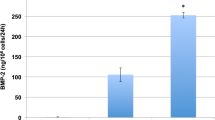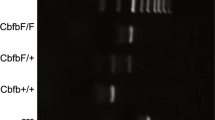Abstract
Lentivirus vectors encoding Wnt10b gene (LV–Wnt10b) or luciferase gene (LV-luc) were constructed to determine whether Wnt10b overexpression improved fracture healing in a rat atrophic non-union model. After fracture, rats were injected with LV-Wnt10b or LV-luc. Luciferase signals were clearly detected. At 2 and 4 weeks, LV-Wnt10b group had 107 and 98 % more proliferating cell nuclear antigen (PCNA) positive cells, respectively, and promoted expression of bone morphogenetic protein-2 (BMP-2) in the callus compared with controls. LV-Wnt10b injection significantly increased bone mass density and bone mineral content: 46–84 and 96–193 %, respectively, at the site of fracturein the LV-Wnt10b group compared with controls. At 8 weeks, fractured femora were healed in the LV-Wnt10b group compared with atrophic non-unions formed in controls. Thus, Wnt10b overexpression associated with lentiviral gene therapy is effective in healing atrophic non-unions in rats.



Similar content being viewed by others
References
Bennett CN, Longo KA, Wright WS, Suva LJ, Lane TF, Hankenson KD, MacDougald OA (2005) Regulation of osteoblastogenesis and bone mass by Wnt10b. Proc Natl Acad Sci USA 102:3324–3329
Bennett CN, Ouyang H, Ma YL, Zeng Q, Gerin I, Sousa KM, Lane TF, Krishnan V, Hankenson KD, MacDougald OA (2007) Wnt10b increases postnatal bone formation by enhancing osteoblast differentiation. J Bone Miner Res 22:1924–1932
Chen Y, Alman BA (2009) Wnt pathway, an essential role in bone regeneration. J Cell Biochem 106:353–362
Chen Y, Whetstone HC, Lin AC, Nadesan P, Wei Q, Poon R, Alman BA (2007) Beta-catenin signaling plays a disparate role in different phases of fracture repair: implications for therapy to improve bone healing. PLoS Med 4:e249
Chow DH, Suen PK, Fu LH, Cheung WH, Leung KS, Wong MW, Qin L (2012) Extracorporeal shockwave therapy for treatment of delayed tendon-bone insertion healing in a rabbit model: a dose-response study. Am J Sports Med 40:2862–2871
Einhorn TA (1998) The cell and molecular biology of fracture healing. Clin Orthop Relat Res 355:S7–21
Eriksson C, Nygren H, Ohlson K (2004) Implantation of hydrophilic and hydrophobic titanium discs in rat tibia: cellular reactions on the surfaces during the first 3 weeks in bone. Biomaterials 25:4759–4766
Hao YJ, Zhang G, Wang YS, Qin L, Hung WY, Leung K, Pei FX (2007) Changes of microstructure and mineralized tissue in the middle and late phase of osteoporotic fracture healing in rats. Bone 41:631–638
Holstein JH, Orth M, Scheuer C, Tami A, Becker SC, Garcia P, Histing T, Morsdorf P, Klein M, Pohlemann T, Menger MD (2011) Erythropoietin stimulates bone formation, cell proliferation, and angiogenesis in a femoral segmental defect model in mice. Bone 49:1037–1045
Iyer M, Salazar FB, Lewis X, Zhang L, Carey M, Wu L, Gambhir SS (2004) Noninvasive imaging of enhanced prostate-specific gene expression using a two-step transcriptional amplification-based lentivirus vector. Mol Ther 10:545–552
Kang S, Bennett CN, Gerin I, Rapp LA, Hankenson KD, Macdougald OA (2007) Wnt signaling stimulates osteoblastogenesis of mesenchymal precursors by suppressing CCAAT/enhancer-binding protein alpha and peroxisome proliferator-activated receptor gamma. J Biol Chem 282:14515–14524
Kato M, Patel MS, Levasseur R, Lobov I, Chang BH, Glass DA, Hartmann C, Li L, Hwang TH, Brayton CF, Lang RA, Karsenty G, Chan L (2002) Cbfa1-independent decrease in osteoblast proliferation, osteopenia, and persistent embryonic eye vascularization in mice deficient in Lrp5, a Wnt coreceptor. J Cell Biol 157:303–314
Kokubu T, Hak DJ, Hazelwood SJ, Reddi AH (2003) Development of an atrophic non-union model and comparison to a closed healing fracture in rat femur. J Orthop Res 21:503–510
Li YH, Zhang K, Yang K, Ye JX, Xing YZ, Guo HY, Deng F, Lian XH, Yang T (2013) Adenovirus-mediated Wnt10b overexpression induces hair follicle regeneration. J Invest Dermatol 133:42–48
Macsai CE, Foster BK, Xian CJ (2008) Roles of Wnt signalling in bone growth, remodelling, skeletal disorders and fracture repair. J Cell Physiol 215:578–587
RundleCH MiyakoshiN, Kasukawa Y et al (2003) In vivo bone formation in fracture repair induced by direct retroviral-based gene therapy with bone morphogenetic protein-4. Bone 32:591–601
Suen PK, He YX, Chow DH et al (2014) Sclerostin monoclonal antibody enhanced bone fracture healing in an open osteotomy model in rats. J Orthop Res 32:997–1005
Uusitalo H, Hiltunen A, Ahonen M, Kahari VM, Aro H, Vuorio E (2001) Induction of periosteal callus formation by bone morphogenetic protein-2 employing adenovirus-mediated gene delivery. Matrix Biol 20:123–127
Virk MS, Conduah A, Park SH et al (2008) Influence of short-term adenoviral vector and prolonged lentiviral vector mediated bone morphogenetic protein-2 expression on the quality of bone repair in a rat femoral defect model. Bone 42:921–931
Yu HM, Jerchow B, Sheu TJ et al (2005) The role of Axin2 in calvarial morphogenesis and craniosynostosis. Development 132:1995–2005
Zheng LW, Ma L, Cheung LK (2008) Changes in blood perfusion and bone healing induced by nicotine during distraction osteogenesis. Bone 43:355–361
Conflicts of interest
The authors declare that they have no conflicts of interest.
Supporting information
Supplementary Figure 1 – HE staining showing bone formation and unions at the fracture site in the LV-luc (a) and LV-Wnbt10 group (b) at 8 weeks post-fracture.
Supplementary Figure 2 – Radiographs of atrophic non-union models in the LV-luc (a, c, e, g) and LV-Wnt10b group (b, d, f, h) obtained at 2 weeks (a, b), 4 weeks (c, d), 6 weeks (e, f) and 8 weeks after surgery (g, h).
Supplementary Figure 3 – LV-Wnt10b treatment enhances total bone mineral density (BMD) (A) and bone mineral content (BMC) (B) in the fracture callus.
Author information
Authors and Affiliations
Corresponding author
Electronic supplementary material
Below is the link to the electronic supplementary material.
Rights and permissions
About this article
Cite this article
Gao, F., Zhang, Cq., Chai, Ym. et al. Lentivirus-mediated Wnt10b overexpression enhances fracture healing in a rat atrophic non-union model. Biotechnol Lett 37, 733–739 (2015). https://doi.org/10.1007/s10529-014-1703-2
Received:
Accepted:
Published:
Issue Date:
DOI: https://doi.org/10.1007/s10529-014-1703-2




